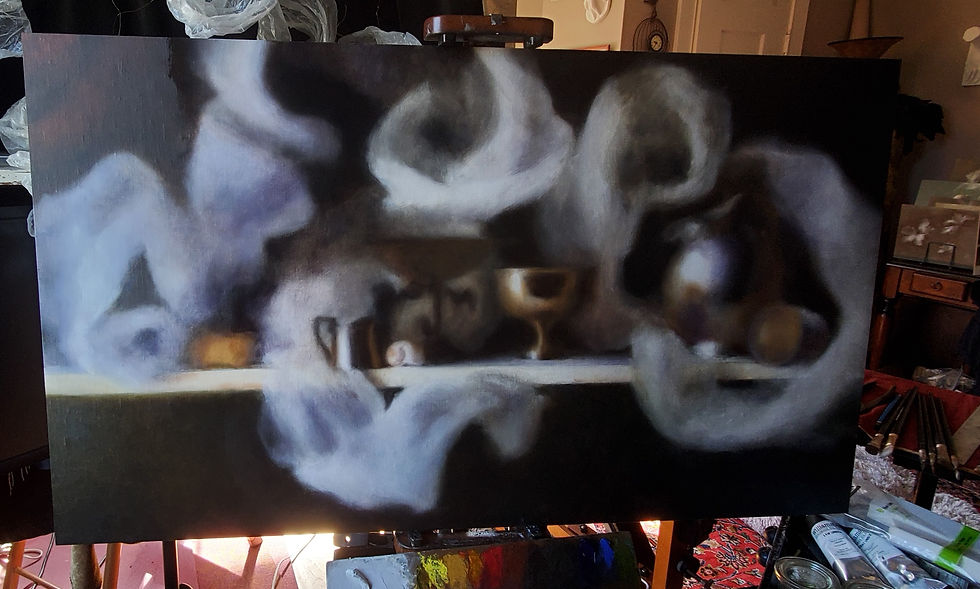I recently finished a commission, the largest still life I've painted to date.

"Atlantis" 24 x 42 inches, Oil on linen, by Sadie Valeri
The objects in the painting are life-size, so to set up the still life, I used pieces of black tape to mark the 42-inch width of the linen panel on my white shelf. I then arranged my composition according to those marks.
I arranged and adjusted the silver vessels, seashells and crumpled wax paper for several days, until I felt a "conversation" begin to emerge. Whenever a composition "clicks", I feel like there is an implied, if not literal, narrative. I don't know the story, but I can feel the relationships between the characters. When the composition was settled, I drew an "X" on the linen panel from corner to corner, and subdivided the panel into quarters and then eighths by dividing the edges with a ruler, making a basic grid to help me visualize the composition. Then, with raw umber paint, I started drawing the basic shapes freehand, massing in a few simplified values. For medium I just used just a little linseed oil mixed 50/50 with mineral spirits for flow and transparency.

My goal for the under painting was just to establish the composition and value pattern quickly. I had already painted a small umber sketch of the composition and created some studies of the individual elements, and so I could sketch in the composition in just a couple hours.
The following day I began to work more slowly. I applied a layer of more opaque paint, working in just one area at a time. From this stage on I added small amounts of stand oil to my basic medium of 50/50 linseed and mineral spirits; a little more stand oil for each layer.

In this layer I painted more subtle value steps, keeping all edges very blurry, by blending neighboring high-contrast edges. I prefer to work this way so I can refine the shapes as the painting progresses, without committing to small details and sharp high-contrast edges that would be difficult to modify later.

At this stage I am using raw umber, lead white, and ultramarine blue, so I can start to think about color temperature in addition to value.

After about three days the second layer was complete, and I could start the third layer, starting from the section at the left again. This time I focused on color, following the under painting as a guide for shapes and values.

I painted more intense colors than I saw, amplifying the hues I could detect in the middle-values. These high-chroma middle values are designed to influence the final layers of the painting, because even the black, white and grey tones of the monochromatic subjects are not completely devoid of color in real life.

With the large shapes, the values and the colors established, I could now start painting details. In the fourth layer I went over the whole painting again, adding detail and sharpening select edges.

Edges and details tend to be very high-contrast, meaning they are often painted with high values (close to white) next to very low values (close to black). Since black and white have zero chroma, they have no color at all, so the color we perceive is mostly visible in the middle values, which I have already painted.
Because the large shapes and the middle hues are already done, the final layers of the painting can be painted very efficiently and relatively quickly.

For the final pass I skipped all over the painting, applying sparkling highlights, glazing shadows darker, and refining the tiniest details.

As the painting comes together at the end, my initial feeling about the relationships between all the objects is realized, and the painting finally evokes the feeling I glimpsed when I first discovered the composition.

"Atlantis" 24 x 42 inches, Oil on linen, by Sadie Valeri
Custom frame by Troy Stafford Custom L84C Artfix Linen panel by RayMar
This painting uses a combination of Alla Prima, Direct, and Indirect painting methods: Indirect
Starts with a detailed drawing and under painting, followed by several layers of full-color painting, wet-over-dry, including glazing and scumbling for a highly refined level of detail.
Direct
Efficient method for creating a finished painting within a few days, in just two to three layers.
Alla Prima
Single-session, wet-in-wet method for quickly capturing fast-changing subjects with fresh brush strokes.
Browse my online art courses or become a member to access all the courses for an affordable monthly rate with personal instruction available.

